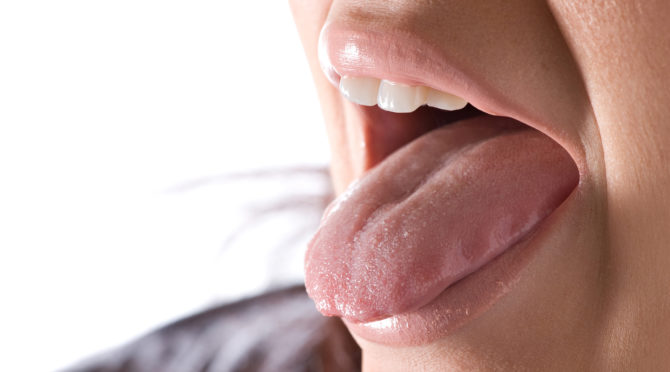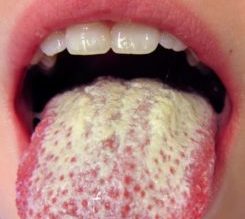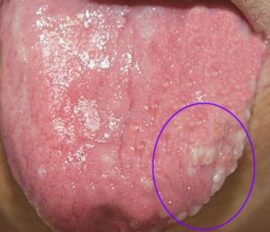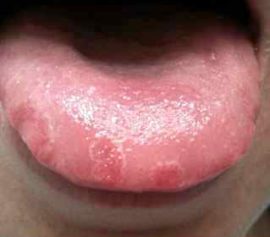Diseases of the tongue: types, symptoms, description of symptoms, photos, treatment
The tongue takes part in the formation of speech, contributes to the full processing of food in the oral cavity and is the strongest muscle. But its mucous membrane is very vulnerable to the action of many negative factors.
In addition to the direct effects of pathogenic microorganisms, thermal burns and trauma to food or teeth, this organ also suffers from many internal diseases. Diseases of the tongue and their symptoms are diverse, therefore treat such diseases under the strict supervision of a dentist, therapist, gastroenterologist or other specialist according to indications.
Content
Under the influence of what factors do diseases of the tongue develop
Diseases of the tongue can occur in a person due to the action of many factors:
- Pathogenic fungi, viruses and bacteria that accumulate in plaque or penetrate the body through the "gateway of infection" - the oral cavity.
- Injuries caused by teeth with inaccurate chewing of food, sharp and hard food, an uncomfortable prosthesis, a fragment of a tooth.
- Contact with food allergens.
- Vitamin deficiency or lack of elements necessary to maintain healthy tissue of the tongue.
- Dehydration due to illness or poor drinking.
- An unhealthy lifestyle with addictions.
- Exchange disorders in the body.
- Defects in blood supply.
- Nervous regulation disorder.
- Neoplasms.
- Congenital malformations.
- The accumulation of toxins and metabolic products in tissues during kidney or liver dysfunction.
- Inflammatory diseases in the digestive and respiratory organs.
- The development of dysbiosis.
Signs and methods of treatment of diseases of the tongue
The action of external and internal factors individually or in a complex way causes various pathologies, among which the most common are infectious, congenital and chronic glossitis, leukoplakia, as well as a symptom complex called glossalgia.
Infectious glossitis
Infectious diseases of the tongue can be recognized by the photo and description, but only a doctor can make an accurate diagnosis.
| Disease name | Pathogen | Symptoms | Treatment |
|---|---|---|---|
| Candidiasis (thrush) | Fungal infection - Candida albicans |
White coating of curdled consistency, as in the photo. Removal of plaque is accompanied by pain and bleeding. Children often have a fever. |
Lubrication of inflamed areas with antifungal ointments, rinsing with soda solution, Furacilin or manganese. |
| Herpetic glossitis | Herpetic viral infection - Herpes simplex virus |
Rashes in the form of small watery bubbles, as in the photo. If they open, erosion appears on the tongue. The rash is painful and accompanied by fever. |
Ingestion of antiviral drugs, lubrication of the rash with antiviral ointments, mouthwash with chlorhexidine. |
| Streptococcal impetigo | Bacterial infection - streptococci |
The tongue becomes inflamed, red spots appear, in the place of which bubbles develop up to 1 cm in diameter, as in the photograph. When opening the vesicles, ulcers form. |
Taking antibiotics inside and in the form of ointments, rinsing the mouth with Furacilin, soda or manganese solution, Chlorhexidine, chamomile broth. |
In addition, treatment of the symptoms accompanying the inflammatory process is carried out: with fever, they use antipyretic drugs, for intolerable pains - analgesics, to prevent dehydration, you should drink more liquid. Regular oral hygiene helps eliminate infection and ulcerative lesions on the surface of the tongue.
Catarrhal and ulcerative glossitis
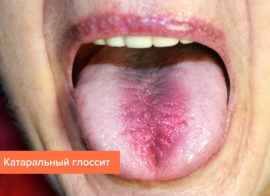 Catarrhal and ulcerative glossitis are also infectious diseases of the tongue, the symptoms and treatment methods of which are similar to the infectious diseases described above. But the cause of the occurrence most often lies not in the infection of the epithelium of the oral cavity itself, but in the complication of common infectious processes (SARS, flu) or inflammation of the gastrointestinal tract. Often this diagnosis is found in smokers and people who abuse alcohol.
Catarrhal and ulcerative glossitis are also infectious diseases of the tongue, the symptoms and treatment methods of which are similar to the infectious diseases described above. But the cause of the occurrence most often lies not in the infection of the epithelium of the oral cavity itself, but in the complication of common infectious processes (SARS, flu) or inflammation of the gastrointestinal tract. Often this diagnosis is found in smokers and people who abuse alcohol.
With the catarrhal form of glossitis, the taste perception changes, pain appears, and tingling occurs. With inflammation, puffiness appears, due to which tooth prints remain on the sides of the tongue. A dense layer of white plaque accumulates on the root of the tongue.
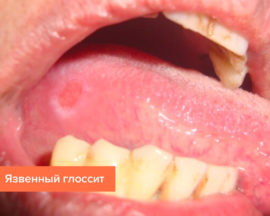 If untreated, catarrhal glossitis goes into ulcerative form with the formation of bleeding ulcerscovered with a layer of dead epithelium, and the appearance of an unpleasant odor.
If untreated, catarrhal glossitis goes into ulcerative form with the formation of bleeding ulcerscovered with a layer of dead epithelium, and the appearance of an unpleasant odor.
With the catarrhal and ulcerative form of glossitis, it is necessary to treat both a general disease, which entailed pathological changes in the tongue, and external manifestations (erosion). May be assigned:
- Antiviral and immunomodulating drugs inside.
- Rinsing the mouth with antiseptics and decoctions of herbs to eliminate inflammation and healing of ulcers that affect the human tongue. You can use a chamomile pharmacy.
- If plaque builds up, wipe it with clean gauze.
Desquamative glossitis
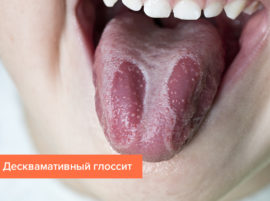 In diseases of the digestive system and metabolic disorders, diathesis, dysbiosis, inflammation of the tongue can be accompanied by a change in the location of the grooves and a densification or desquamation of the papillae. Subsequently, pink and red spots appear on the surface, clearly delimited by whitish rollers. This set of symptoms is called "geographical language."
In diseases of the digestive system and metabolic disorders, diathesis, dysbiosis, inflammation of the tongue can be accompanied by a change in the location of the grooves and a densification or desquamation of the papillae. Subsequently, pink and red spots appear on the surface, clearly delimited by whitish rollers. This set of symptoms is called "geographical language."
To eliminate the pathology, it is necessary to treat the disease that led to such changes. Depending on the cause of the pathology, the patient is prescribed different groups of drugs:
- Antiallergic.
- Vitamin.
- Anti-inflammatory.
- Probiotics to eliminate dysbiosis.
For local treatment of the diseased tongue, rinses with antiseptics and lubrication of the mucous membrane with vitamin A are used.
Congenital malformations of the tongue
 Rhomboid glossitis is caused by congenital features of muscle development. It appears as a growth on the back of the tongue (near the root) up to 10 mm in length, characterized by a glossy surface of bright red color.
Rhomboid glossitis is caused by congenital features of muscle development. It appears as a growth on the back of the tongue (near the root) up to 10 mm in length, characterized by a glossy surface of bright red color.
Folded glossitis is characterized by congenital uncharacteristic folds in the tongue, although the mucous membrane has a normal color. In the absence of other diseases, this feature does not bring discomfort, but metabolic disturbances and vitamin deficiencies can provoke keratinization and cracking of the surface of the folds.
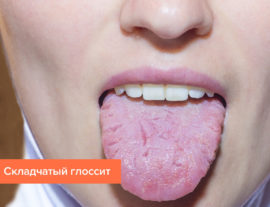 Treatment may include the following areas:
Treatment may include the following areas:
- If such diseases are complicated by infection or cracking of the tongue, it is necessary to treat the oral cavity with antiseptics.
- With vitamin deficiency, a special diet and the intake of vitamins in the form of medications are indicated.
- With rhomboid glossitis, the cryotherapy method is used. To avoid complications, patients with similar problems are not recommended to smoke.
Hairy black tongue
The name of this disease of the tongue is explained by its photo and description of symptoms. The tongue really looks hairy, but this effect occurs due to the pathological proliferation of the papillae on its back closer to the root. They can reach 2 centimeters in length. Gradually, these structures die off and become black.
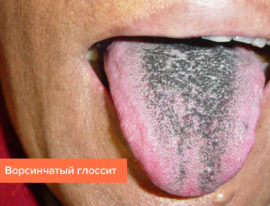 The cause of this pathology is a metabolic disorder or the intake of drugs harmful to the body. To provoke the growth and death of the papillae can tobacco smoke and alcohol, affecting the body for many years. Doctors admit that the disease may be due to genetic mutations.
The cause of this pathology is a metabolic disorder or the intake of drugs harmful to the body. To provoke the growth and death of the papillae can tobacco smoke and alcohol, affecting the body for many years. Doctors admit that the disease may be due to genetic mutations.
They treat such a disease with the help of antiseptic agents for washing off plaque and keratolytic agents. Papillae, which become inflamed and die, can be removed by cryodestruction. It is necessary to observe a sparing diet, stop smoking and spicy annoying food.
Leukoplakia
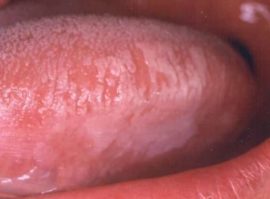 Such a tongue disease often occurs in men in adulthood and is usually associated with metabolic malfunctions or digestive diseases. Leukoplakia does not cause pain, but the patient may feel uncomfortable with spicy foods. Symptoms of this disease of the tongue can be seen in the photo on the right. The mucous organ is covered with whitish plaques, which extend to other parts of the oral cavity, can appear in the corners of the mouth. After a few weeks, the affected epithelium thickens.
Such a tongue disease often occurs in men in adulthood and is usually associated with metabolic malfunctions or digestive diseases. Leukoplakia does not cause pain, but the patient may feel uncomfortable with spicy foods. Symptoms of this disease of the tongue can be seen in the photo on the right. The mucous organ is covered with whitish plaques, which extend to other parts of the oral cavity, can appear in the corners of the mouth. After a few weeks, the affected epithelium thickens.
Treatment of a provoking disease is necessary. The affected areas of the tongue are cleaned with:
- Laser therapy.
- Radio waves.
- Electroexcision method.
- Method diathermocoagulation.
If the doctor suspects the degeneration of cells into malignant, surgical treatment will be performed.
Glossalgia
This language problem is caused by frequent injuries in the mouth or serious violations in the work of internal organs, more often pathology affects elderly patients. Glossalgia is not a separate disease, it is a complex of symptoms inherent in some diseases.
With glossalgia, there are practically no visible external signs - redness or the appearance of ulcers. Only in some severe cases is a grayish coating. The sick person himself feels the manifestation of the pathology: the tongue becomes painful in one place, or the pain diverges throughout the muscle. Due to the dryness of the mucous membrane, severe itching or tingling occurs, and the discomfort usually increases with excitement.
Sometimes the pain syndrome disappears on its own, but to ignore and accurately diagnose such signs of the disease is unacceptable. The dentist must carry out a complete sanitation of the mouth, check the condition of the prostheses, if any, - they can cause permanent injury. If an internal disease is detected, the detected problem must be treated. If the tongue hurts very much, discomfort is eliminated with the help of analgesics.
The oral cavity can be exposed to various harmful effects, therefore, to prevent diseases of the tongue in a person and eliminate their symptoms, comprehensive health care is necessary. If signs of the disease appear, you should consult a doctor and carefully follow his instructions. In order not to miss the initial stages of pathologies, you need to carefully look at the surface of the tongue in the mirror from time to time.

